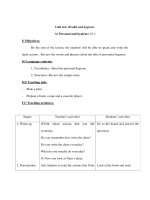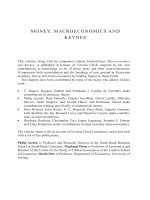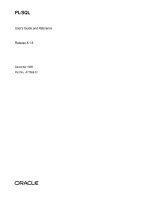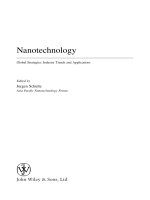Software Fault Tolerance Techniques and Implementation phần 1 potx
Bạn đang xem bản rút gọn của tài liệu. Xem và tải ngay bản đầy đủ của tài liệu tại đây (729.72 KB, 35 trang )
TEAMFLY
Team-Fly
®
Software Fault Tolerance Techniques
and Implementation
Limits of Liability and Disclaimer of Warranty
Every reasonable attempt has been made to ensure the accuracy, complete-
ness, and correctness of the information contained in this book at the time of
writing. However, neither the author nor the publisher, Artech House, Inc.,
shall be responsible or liable in negligence or otherwise, in respect to any
inaccuracy or omission herein. The author and the publisher make no repre-
sentation that this information is suitable for every application to which a
reader may attempt to apply the information. Many of the techniques and
theories are still subject to academic debate. The author and Artech House
make no warranty of any kind, expressed or implied, including warranties of
fitness for a particular purpose, with regard to the information contained in
this book, all of which is provided as is. Without derogating from the gen-
erality of the foregoing, neither the author nor the publisher shall be liable
for any direct, indirect, incidental, or consequential damages or loss caused
by or arising from any information or advice, inaccuracy, or omission herein.
This work is published with the understanding that the author and Artech
House are supplying information, but are not attempting to render engineer-
ing judgment or other professional services.
For a complete listing of the Artech House Computing Library,
turn to the back of this book.
Software Fault Tolerance Techniques
and Implementation
Laura L. Pullum
Artech House
Boston London
www.artechhouse.com
Library of Congress Cataloging-in-
Publication Data
Pullum, Laura.
Software fault tolerance techniques and implementation / Laura Pullum.
p. cm. - (Artech House computing library)
Includes bibliographical references and index.
ISBN 1-58053-137-7 (alk. paper)
1. Fault -tolerant computing.
2. Computer software-Reliability.
I. Title. II. Series.
QA76.9.F38 P85
2001 005.1-dc21
2001035915
British Library Cataloguing in Publication Data
Pullum, Laura
Software fault tolerance techniques and implementation. -
(Artech House computing library)
1. Computer software-Development
2. Software failures
I. Title
005.1’2
ISBN
1
-
58053
-
470
-
8
Cover design by Igor Valdman
© 2001 ARTECH HOUSE,
INC. 685 Canton Street
Norwood, MA 02062
All rights reserved. Printed and bound in the United States of America. No part of this book
may be reproduced or utilized in any form or by any means, electronic or mechanical, in
-
cluding p
hotocopying, recording, or by any information storage and retrieval system, with
out permission in writing from the publisher.
All terms mentioned in this book that are known to be trademarks or service marks have
been appropriately capitalized. Artech Ho
use cannot attest to the accuracy of this informa
tion. Use of a term in this book should not be regarded as affecting the validity of any trade
mark or service mark.
International Standard Book Number: 1-58053-137-7
Library of Congress Catalog Card Number: 2001035915
10 9 8 7 6 5 4 3 2 1
Contents
Preface xi
Acknowledgments xiii
1 Introduction 1
1.1 A Few Definitions 3
1.2 Organization and Intended Use 4
1.3 Means to Achieve Dependable Software 6
1.3.1 Fault Avoidance or Prevention 7
1.3.2 Fault Removal 9
1.3.3 Fault/Failure Forecasting 11
1.3.4 Fault Tolerance 12
1.4 Types of Recovery 13
1.4.1 Backward Recovery 14
1.4.2 Forward Recovery 16
1.5 Types of Redundancy for Software Fault Tolerance 18
1.5.1 Software Redundancy 18
v
1.5.2 Information or Data Redundancy 19
1.5.3 Temporal Redundancy 21
1.6 Summary 21
References 23
2 Structuring Redundancy for Software Fault
Tolerance 25
2.1 Robust Software 27
2.2 Design Diversity 29
2.2.1 Case Studies and Experiments in Design Diversity 31
2.2.2 Levels of Diversity and Fault Tolerance Application 33
2.2.3 Factors Influencing Diversity 34
2.3 Data Diversity 35
2.3.1 Overview of Data Re-expression 37
2.3.2 Output Types and Related Data Re-expression 38
2.3.3 Example Data Re-expression Algorithms 40
2.4 Temporal Diversity 42
2.5 Architectural Structure for Diverse Software 44
2.6 Structure for Development of Diverse Software 44
2.6.1 Xu and Randell Framework 45
2.6.2 Daniels, Kim, and Vouk Framework 51
2.7 Summary 53
References 53
3 Design Methods, Programming Techniques,
and Issues 59
3.1 Problems and Issues 59
LE Software Fault Tolerance Techniques and Implementation
3.1.1 Similar Errors and a Lack of Diversity 60
3.1.2 Consistent Comparison Problem 62
3.1.3 Domino Effect 68
3.1.4 Overhead 70
3.2 Programming Techniques 76
3.2.1 Assertions 78
3.2.2 Checkpointing 80
3.2.3 Atomic Actions 84
3.3 Dependable System Development Model and
N-Version Software Paradigm 88
3.3.1 Design Considerations 88
3.3.2 Dependable System Development Model 91
3.3.3 Design Paradigm for N-Version Programming 93
3.4 Summary 94
References 97
4 Design Diverse Software Fault Tolerance
Techniques 105
4.1 Recovery Blocks 106
4.1.1 Recovery Block Operation 107
4.1.2 Recovery Block Example 113
4.1.3 Recovery Block Issues and Discussion 115
4.2 N-Version Programming 120
4.2.1 N-Version Programming Operation 121
4.2.2 N-Version Programming Example 125
4.2.3 N-Version Programming Issues and Discussion 127
4.3 Distributed Recovery Blocks 132
4.3.1 Distributed Recovery Block Operation 132
4.3.2 Distributed Recovery Block Example 137
4.3.3 Distributed Recovery Block Issues and Discussion 139
Contents LEE
4.4 N Self-Checking Programming 144
4.4.1 N Self-Checking Programming Operation 144
4.4.2 N Self-Checking Programming Example 145
4.4.3 N Self-Checking Programming Issues and Discussion 149
4.5 Consensus Recovery Block 152
4.5.1 Consensus Recovery Block Operation 152
4.5.2 Consensus Recovery Block Example 155
4.5.3 Consensus Recovery Block Issues and Discussion 159
4.6 Acceptance Voting 162
4.6.1 Acceptance Voting Operation 162
4.6.2 Acceptance Voting Example 166
4.6.3 Acceptance Voting Issues and Discussion 169
4.7 Technique Comparisons 172
4.7.1 N-Version Programming and Recovery Block
Technique Comparisons 176
4.7.2 Recovery Block and Distributed Recovery Block
Technique Comparisons 180
4.7.3 Consensus Recovery Block, Recovery Block
Technique, and N-Version Programming
Comparisons 181
4.7.4 Acceptance Voting, Consensus Recovery Block,
Recovery Block Technique, and N-Version
Programming Comparisons 182
References 183
5 Data Diverse Software Fault Tolerance Techniques 191
5.1 Retry Blocks 192
5.1.1 Retry Block Operation 193
5.1.2 Retry Block Example 202
5.1.3 Retry Block Issues and Discussion 204
5.2 N-Copy Programming 207
LEEE Software Fault Tolerance Techniques and Implementation
5.2.1 N-Copy Programming Operation 208
5.2.2 N-Copy Programming Example 212
5.2.3 N-Copy Programming Issues and Discussion 214
5.3 Two-Pass Adjudicators 218
5.3.1 Two-Pass Adjudicator Operation 218
5.3.2 Two-Pass Adjudicators and Multiple Correct Results 223
5.3.3 Two-Pass Adjudicator Example 227
5.3.4 Two-Pass Adjudicator Issues and Discussion 229
5.4 Summary 232
References 233
6 Other Software Fault Tolerance Techniques 235
6.1 N-Version Programming Variants 235
6.1.1 N-Version Programming with Tie-Breaker and
Acceptance Test Operation 236
6.1.2 N-Version Programming with Tie-Breaker and
Acceptance Test Example 241
6.2 Resourceful Systems 244
6.3 Data-Driven Dependability Assurance Scheme 247
6.4 Self-Configuring Optimal Programming 253
6.4.1 Self-Configuring Optimal Programming Operation 253
6.4.2 Self-Configuring Optimal Programming Example 257
6.4.3 Self-Configuring Optimal Programming Issues and
Discussion 260
6.5 Other Techniques 262
6.6 Summary 262
References 265
Contents EN
7 Adjudicating the Results 269
7.1 Voters 270
7.1.1 Exact Majority Voter 273
7.1.2 Median Voter 278
7.1.3 Mean Voter 282
7.1.4 Consensus Voter 289
7.1.5 Comparison Tolerances and the Formal Majority
Voter 295
7.1.6 Dynamic Majority and Consensus Voters 303
7.1.7 Summary of Voters Discussed 309
7.1.8 Other Voters 311
7.2 Acceptance Tests 311
7.2.1 Satisfaction of Requirements 314
7.2.2 Accounting Tests 315
7.2.3 Reasonableness Tests 315
7.2.4 Computer Run-Time Tests 318
7.3 Summary 319
References 320
List of Acronyms 325
About the Author 329
Index 331
N Software Fault Tolerance Techniques and Implementation
TEAMFLY
Team-Fly
®
2HAB=?A
The scope, complexity, and pervasiveness of computer-based and controlled
systems continue to increase dramatically. The consequences of these sys-
tems failing can range from the mildly annoying to catastrophic, with serious
injury occurring or lives lost, human-made and natural systems destroyed,
security breached, businesses failed, or opportunities lost. As software
assumes more of the responsibility of providing functionality and control in
systems, it becomes more complex and more significant to the overall system
performance and dependability.
It would be ideal if the processes by which software is conceptualized,
created, analyzed, and tested had advanced to the state that software is devel-
oped without errors. Given the current state-of-the-practice, fewer errors are
introduced, but not all errors are prevented. So even if we have the best peo-
ple and use the best practices and tools, we are still imperfect beings, and it
would be very risky to assume that the software we develop is error-free. This
book examines the means to protect against software design faults and toler-
ate the operational effects of these introduced imperfections.
Chapter 1 provides definitions of several basic terms and concepts and
a proposed reading guide. Chapter 2 presents various means of structuring
redundancy so that it can effect software fault tolerance. Chapter 3 presents
programming practices used in several software fault tolerance techniques,
along with common problems and issues faced by various approaches to soft-
ware fault tolerance.
The essence of this book is the presentation of the software fault tol-
erance techniques themselves. Design diverse techniques are presented in
NE
Chapter 4, data diverse techniques in Chapter 5, and other techniques in
Chapter 6. The decision mechanisms used with many of the techniques are
presented in Chapter 7.
This book may be used as a reference for researchers or practitioners. It
may also be used as a textbook or reference for a graduate-level software engi-
neering course or for a course on software fault tolerance. A proposed naviga-
tional guide to reading the book is provided in Figure 1.1, Section 1.2.
Software fault tolerance is not a panacea for all our software problems.
Since, at least for the near future, software fault tolerance will primarily be
used in critical systems, it is even more important to emphasize that fault
tolerant does not mean safe, nor does it cover the other attributes com-
prising dependability, such as reliability, availability, confidentiality, integ-
rity, and maintainability (as none of these covers fault tolerance). Each must
be designed-in and their, at times conflicting, characteristics analyzed. Poor
requirements analysis will yield poor software in most cases. Simply applying
a software fault tolerance technique prior to testing or fielding a system is
not sufficient. Software due diligence is required!
NEE Software Fault Tolerance Techniques and Implementation
Acknowledgments
I am grateful to the staff at Artech House Publishers and to the reviewers
for their encouragement and support during the process of writing and pro-
ducing this book.
I would be happy to hear from readers who have updated research
findings, implementation examples , new tec hniques, or other informa-
tion that mig ht enh ance the usefulness of this book in any future updates.
Such comments and sugge stions can be se nt to me via e-mail at
NEEE
1
Introduction
Computer-based systems have increased dramatically in scope, complexity,
and pervasiveness, particularly in the past decade. Most industries are highly
dependent on computers for their basic day-to-day functioning. Safe and
reliable software operation is a significant requirement for many types of sys-
tems, for instance, in aircraft and air traffic control, medical devices, nuclear
safety, petrochemical control, high-speed rail, electronic banking and
commerce, automated manufacturing, military and nautical systems, for
aeronautics and space missions, and for appliance-type applications such
as automobiles, washing machines, temperature control, and telephony, to
name a few. The cost and consequences of these systems failing can range
from mildly annoying to catastrophic, with serious injury occurring or lives
lost, systems (both human-made and natural) destroyed, security breached,
businesses failed, or opportunities lost. As software assumes more of the
responsibility for providing functionality in these systems, it becomes more
complex and more significant to the overall system performance and
dependability.
Ideally, the processes by which software is conceptualized, created, ana-
lyzed, and tested would have advanced to the point where software could be
developed without errors. The current state-of-the-practice is such that fewer
errors are introduced, but unfortunately not all errors are prevented. Even if
the best people, practices, and tools are used, it would be very risky to assume
the software developed is error-free. There may also be cases in which an
error, found late in the systems life cycle and perhaps prohibitively expensive
to repair, is knowingly allowed to remain in the system.
Examples of events, with a range of consequences, in which software is
thought to be a contributing factor are briefly noted below. Additional exam-
ples of reported software-related accidents and incidents are related by Peter
G. Neumann in Computer Related Risks [1] (Chapter 2) and in the archives of
the Internet Risks Forum he moderates, by Nancy G. Leveson in Safeware
[2] (appendixes), and by Debra S. Herrmann in Software Safety and Reliabil-
ity [3] (Chapter 1).
•
The aerospace industry has unique challenges and takes exceptional
care in software development. Despite the care taken, several
software-related incidents have caused widespread attention. A few
examples include: problems in the backup tracking software delayed
the launch of Atlantis (STS-36) for three days [4]; software on the
space shuttle Endeavor (STS-49) effectively rounded near-zero val-
ues to zero, causing problems when attempting rendezvous with
Intelstat 6 [57]; and an Apollo 11 software flaw made the moons
gravity repulsive rather than attractive [1, 8].
• In January 1990, the AT&T system suffered a nine-hour United
Stateswide blockade [9] when one switch experienced abnormal
behavior and attempted recovery. Because of a flaw in recovery-
recognition software (in all 114 switches) and a network design that
permitted propagation of the effects, the problem spread to all
switches.
•
During the Persian Gulf War, clock drift in the Patriot system
caused it to miss a scud missile that hit an American barracks in
Dhahran. The missile hit killed 29 people and injured 97 others.
The clock drift was reportedly caused by the softwares use of two
different and unequal representations (24-bit and 48-bit) of the
value 0.1 [1011]. As with most complex systems, the source of the
resulting problem was multifaceted, in this case with software one of
several problem sources.
•
Several Airbus A320 problems (e.g., [1216]) have been initially
blamed on the pilots and their skills in handling anomalous situa-
tions. However, serious questions have been raised about the role
software may have played in these incidents.
•
Six known accidental massive radiation overdoses by the Therac-25
radiation therapy system had software error as their precipitating
event. A thorough account of the Therac-25 accidents is provided
in [17].
2 Software Fault Tolerance Techniques and Implementation
•
A software problem caused radiation safety doors in the Sellafield,
United Kingdom, nuclear reprocessing plant to be opened acciden-
tally [18].
•
A recent report outlined the impact of major system outages on vari-
ous businesses, noting that the cost for a brokerage is $6.5 million
per hour, the cost per hour for a credit-card authorization system
is $2.6 million, and for an automated teller machine, $14,500 in
automatic teller machine fees [19].
Increasing the dependability of software presents some unique challenges
when compared to traditional hardware systems. Hardware faults are pri-
marily physical faults, which can be characterized and predicted over time.
Software does not physically wear out, burn out, or otherwise physically
deteriorate with time (although it can be argued that the value of specific
instances of data and software may degrade over time). Software has only
logical faults, which are difficult to visualize, classify, detect, and correct.
Software faults may be traced to incorrect requirements (where the software
matches the requirements, but the behavior specified in the requirements is
not appropriate) or to the implementation (software design and coding) not
satisfying the requirements. Changes in operational usage or incorrect modi-
fications may introduce new faults. To protect against these faults, we cannot
simply add redundancy, as is typically done for hardware faults, because
doing so will simply duplicate the problem. So, to provide protection against
these faults, we turn to software fault tolerance.
1.1 A Few Definitions
To provide additional basis for the discussions in the remainder of this book,
a few basic definitions are provided.
A fault is the identified or hypothesized cause of an error [20], some-
times called a bug. It can be viewed as simply the consequence of a failure
of some other system (including the developer) that has delivered or is now
delivering a service to the given system [21]. An active fault is one that pro-
duces an error.
An error is part of the system state that is liable to lead to a failure [21].
It can be unrecognized as an error (i.e., latent) or detected. An error may
propagate, that is, produce other errors. Faults are known to be present when
errors are detected.
Introduction !
A failure occurs when the service delivered by the system deviates from
the specified service, otherwise termed an incorrect result [21]. This implies
that the expected service is described, typically by a specification or set of
requirements.
So, with software fault tolerance, we want to prevent failures by tol-
erating faults whose occurrences are known when errors are detected. The
cycle…failure→fault→error→failure→fault…indicates their general
causal relationship. The causal order is maintained, however the generality is
exhibited when, for example, an error leads to a fault without an observed
failure (if observation capabilities are not in place or are inadequate). Another
example of the generality is when one or more errors occur before a failure
due to those errors occurs. The classic definition [22, 23] of software fault tol-
erance is: using a variety of software methods, faults (whose origins are related
to software) are detected and recovery is accomplished.
1.2 Organization and Intended Use
This book is organized as follows. The remainder of this chapter describes
how software fault tolerance is an important means to achieve dependable
software, the types of recovery used in fault tolerant software, and the types
of redundancy used in software fault tolerance techniques. Redundancy
alone is not sufficient for detecting and tolerating software faults. It requires
some form of diversity to achieve software fault tolerance. Chapter 2 presents
various means of structuring redundancy, for example, via forms of diversity,
so that it can effect software fault tolerance. Some programming methods
are used in several different software fault tolerance techniques or are simply
important enough to discuss apart from the techniques in which they are
used. These programming methods are discussed in Chapter 3, along with
common problems and issues faced by various approaches to software fault
tolerance.
The essence of this book is the presentation of the software fault toler-
ance techniques themselves, including the way they operate, usage scenarios,
examples, and issues. The techniques are categorized and discussed accord-
ing to type of diversitydesign diverse techniques in Chapter 4, data diverse
techniques in Chapter 5, and the catch-all other techniques in Chapter 6.
Just as we were able to extract some issues and programming methods com-
mon to several software fault tolerance techniques, we can also extract and
discuss the decision mechanisms (DM) used with many of the techniques.
This is done in Chapter 7.
4 Software Fault Tolerance Techniques and Implementation
A word of caution is perhaps in order now: this book is not meant to be
read straight through, particularly Chapters 4, 5, and 6. End-to-end reading
may turn away even the most ardent admirer of software fault tolerance.
Particularly in Chapters 4, 5, and 6, it may be best to select a technique
of interest to learn about and investigate, rather than reading about all
the techniques in a single sitting. The book may be used as a reference for
researchers or practitioners. It may also be used as a textbook or reference
for a graduate-level software engineering course or for a course on software
fault tolerance. Figure 1.1 provides a proposed navigational guide to reading
this book.
Introduction 5
Background
and basics
(Chapters 1, 2, 3)
Basic decision
mechanisms
(Sections 7.1.17.1.3,
7.1.7, 7.2)
Basic and classic
techniques
(Sections 4.1, 4.2,
4.7.1, 5.1, 5.2)
AdvancedBasic
Advanced decision
mechanisms
(Sections 7.1.47.1.6,
7.1.8)
More complex
techniques
(Sections 4.34.6,
4.7.24.7.4, 5.3, Chapter 6)
Alternate pathAlternate path
Figu re 1.1 A pro posed guide to reading th is book.
1.3 Means to Achieve Dependable Software
We have stated that the need for dependable software in general, and soft-
ware fault tolerance in particular, arises from the pervasiveness of software, its
use in both critical and everyday applications, and its increasing complexity.
In this section, the various technical means to achieve dependable software
are briefly discussed.
The concepts related to dependable software can be classified in the
form of a tree as shown in Figure 1.2 (adapted from [24]), a dependability
concept classification. The tree illustrates the impairments, means, and
attributes of dependability. The impairments, or those things that stand in
the way of dependability, are faults, errors, and failures (discussed earlier).
The attributes of dependability enable the properties of dependability and
provide a way to assess achievement of those properties. Additional attributes
can be derived from the properties of those listed. For example, the depend-
able system attribute security is derived from the properties of integrity,
availability, and confidentiality.
6 Software Fault Tolerance Techniques and Implementation
Fault forecasting
Fault removal
Fault tolerance
Fault avoidance
Construction
Validation
Means
Availability
Reliability
Failures
Safety
Confidentiality
Attributes
Impairments
Dependability
Integrity
Maintainability
Errors
Faults
Figu re 1.2 Depe ndability concept classification. (After: [24].)
TEAMFLY
Team-Fly
®
The means to achieve dependability falls into two major groups: (1)
those that are employed during the software construction process (fault
avoidance and fault tolerance), and (2) those that contribute to validation of
the software after it is developed (fault removal and fault forecasting). Briefly,
the techniques are:
•
Fault avoidance or prevention: to avoid or prevent fault introduction
and occurrence;
•
Fault removal: to detect the existence of faults and eliminate them;
•
Fault/failure forecasting: to estimate the presence of faults and the
occurrence and consequences of failures;
•
Fault tolerance: to provide service complying with the specification
in spite of faults.
The remainder of this section investigates each of the techniques in more
detail.
1.3.1 Fault Avoidance or Prevention
Fault avoidance or prevention techniques are dependability enhancing tech-
niques employed during software development to reduce the number of
faults introduced during construction. These avoidance, or prevention,
techniques may address, for example, system requirements and specifica-
tions, software design methods, reusability, or formal methods. Fault avoid-
ance techniques contribute to system dependability through rigorous
specification of system requirements, use of structured design and program-
ming methods, use of formal methods with mathematically tractable lan-
guages and tools, and software reusability.
1.3.1.1 System Requirements Specification
The specification of system requirements is currently an imperfect process at
best. A system failure may occur due to logic errors incorporated into the
requirements. This results in software that is written to match the require-
ments, but the behavior specified in the requirements is not the expected
or desired system behavior. This type of fault often occurs because software
requirements specification lies at the intersection between software engineer-
ing and system engineering, and these two disciplines suffer from a lack of
communication. All too often, software engineers tend to work in isolation
from the rest of a systems developers. This is especially problematic from the
Introduction 7
safety standpoint, since the majority of safety problems arise from software
requirements errors and not coding errors [2]. Some software engineering
techniques support interactive refinement of requirements and engineer-
ing of the requirements specification process. However, a much larger part of
existing software engineering techniques addresses only the errors that occur
when the design and implementation of the requirements in a programming
language do not match or satisfy the system requirements.
1.3.1.2 Structured Design and Programming Methods
Many structured software design and programming methods have been
shown to be effective and are in common use. Most of them introduce struc-
ture to the design to reduce the complexity and interdependency of compo-
nents. The principles of decoupling and modularization can be applied to
software as well as system design. Further, information hiding encourages
each component to encapsulate design decisions and hide them from other
modules, while communicating only via explicit function calls and parame-
ters. Each of these techniques reduces overall complexity of the software,
making it easier to understand and implement and, hence, reduces the intro-
duction of faults into the software.
1.3.1.3 Formal Methods
Formal methods have been used, particularly in the research community,
to improve software dependability during construction. In these approaches,
requirements specifications are developed and maintained using mathemati-
cally tractable languages and tools. Lyu [25] describes four goals of current
formal methods studies: (1) executable specifications for systematic and
precise evaluation, (2) proof mechanisms for software verification and vali-
dation, (3) development procedures that follow incremental refinement for
step-by-step verification, and (4) every work item, be it a specification or
a test case, is subject to mathematical verification for correctness and
appropriateness.
Mathematical specifications of proofs of software properties tend to
be the same size as the program, difficult to construct, and often harder
to understand than the program itself. As a result, they can be just as prone
to error as the software under scrutiny. Because of these concerns, formal
methods have not been generally used on large projects. However, if a spe-
cific part of a system is indicated for risk mitigation, the analyst may find the
size of the component small enough that the use of formal methods on that
component is not prohibitive in terms of cost, time, or other resources.
8 Software Fault Tolerance Techniques and Implementation
1.3.1.4 Software Reuse
Software reuse is very attractive for a variety of reasons. Software reusability
implies a savings in development cost, since it reduces the number of com-
ponents that must be originally developed. It is also popular as a means of
increasing dependability because software that has been well exercised is less
likely to fail (since many faults have already been identified and corrected).
In addition, object-oriented paradigms and techniques encourage and sup-
port software reuse. However, it is important to recognize that different
measures of dependability may not be improved equally by reuse of software.
For example, highly reliable software may not necessarily be safe.
1.3.1.5 Fault Avoidance/Prevention Summary
Interactive refinement of the users system requirements, the engineering
of the software specification process, the use of good software programming
discipline, and the encouragement of writing clear code are the generally
accepted and employed approaches to prevent faults in software. These are
fundamental techniques in preventing software faults from being created.
Formal methods are very thorough, using mathematically tractable languages
and tools to verify correctness and appropriateness. The major drawback of
formal methods is that the size and complexity of the verification tends to
be at least as great as that of the software under scrutiny, imposing a large
overhead on the development process. This overhead is usually unacceptable,
except for small components that are highly critical to the entire system.
Fault prevention through reusability of code components is popular and can
be quite helpful when the code to be reused has been proven dependable.
The pitfall here is that simply reusing code does not ensure dependability,
especially if the new requirements do not match the requirements to which
the code was originally written. It is difficult to quantify the impact of fault
avoidance techniques on system dependability. Despite fault prevention
efforts, faults are created, so fault removal is needed.
1.3.2 Fault Removal
Fault removal techniques are dependability-enhancing techniques employed
during software verification and validation. These techniques improve soft-
ware dependability by detecting existing faults, using verification and vali-
dation (V&V) methods, and eliminating the detected faults. Fault removal
techniques contribute to system dependability using software testing, formal
inspection, and formal design proofs.
Introduction 9
1.3.2.1 Software Testing
The most common fault removal techniques involve testing. An overview of
software-testing techniques is provided by the author in [26]. The difficulties
encountered in testing programs are often related to the prohibitive cost and
complexity of exhaustive testing [27] (testing the software under all circum-
stances using all possible input sets). The key to efficient testing is to main-
tain adequate test coverage and to derive appropriate test quality measures.
It follows that minimizing component size and interrelationships maximizes
accurate testing.
Additional testing may be performed on components identified as criti-
cal to the system. This additional testing may reveal unforeseen problems or
may increase the confidence in the predicted probability of failure for that
component.
1.3.2.2 Formal Inspection
Formal inspection [28] is another practical fault removal technique that has
been widely implemented in industry and that has shown success in many
companies [29]. This technique is a rigorous process, accompanied by docu-
mentation that focuses on examining source code to find faults, correcting
the faults, and then verifying the corrections. Formal inspection is usually
performed by small peer groups prior to the testing phase of the life cycle.
1.3.2.3 Formal Design Proofs
Formal design proofs are closely related to formal methods. This emerging
technique attempts to achieve mathematical proof of correctness for pro-
grams. Using executable specifications, test cases can be automatically gen-
erated to improve the software verification process. This technique is not
currently fully developed and, as with formal methods, may be a costly and
complex technique to use. However, if performed on a relatively small por-
tion of the code (identified as critical during the risk identification stage),
formal design proofs may be feasible. The successful completion of a formal
proof may give the designer a high degree of confidence in predicting a very
low probability of failure for a software artifact.
1.3.2.4 Fault Removal Summary
Software testing and formal inspections are commonly used fault removal
techniques. They introduce rigor to the process of fault removal. It is
important that these techniques are used efficiently and with more emphasis
on software components that are critical to the system and its dependability.
10 Software Fault Tolerance Techniques and Implementation









